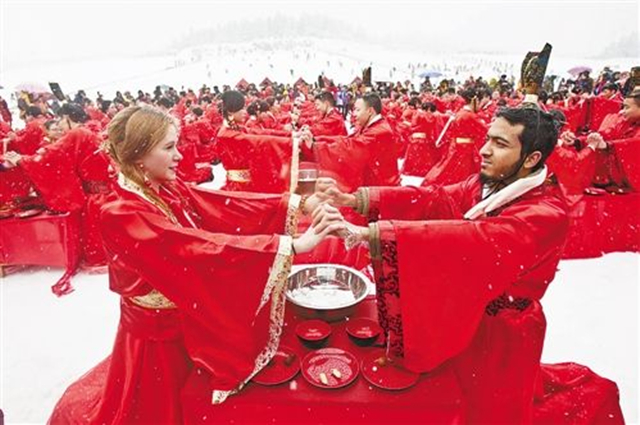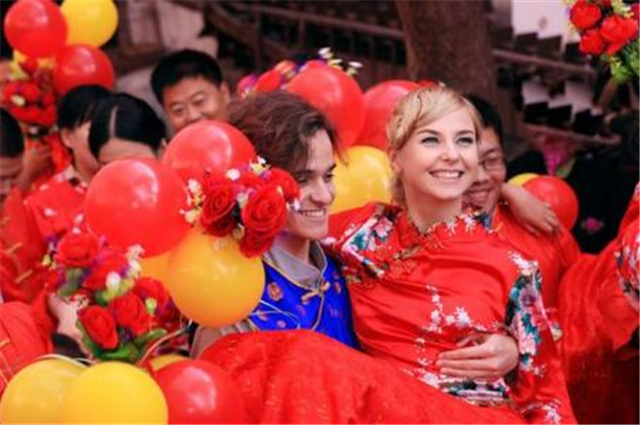Marriage Release time:November 28,2023



Before the marriage, there are several stages: asking the name, discussing the bride-price, engagement, discussing the wedding date, wedding (marriage), formal ceremony, returning home.
Asking the name: Once the parents of both sides agree to the future marriage, the boy's family will ask the go-between to get the girl's "eight characters" (i.e., the heavenly stems and earthly branches of the year, month, day and hour when the girl was born) and present to the fortune-teller to practice divination.
Discussing the bride-price: After the fortune-teller has practiced divination that the "eight characters" of the boy and girl match properly and the parents of both sides agree on engagement, the boy's family will ask the go-between to discuss the bride-price with the girl's family.
Engagement: After the bride-price has been fixed, both sides will choose a day to arrange a dinner for engagement. On that day, the friends and relatives will come to congratulate on the engagement and the boy's family will present the bride-price and betrothal gifts to the girl's family. If the girl's family accepts the bride-price and betrothal gifts, it means they agree to the marriage.
Discussing the wedding date: After the engagement, the wedding date needs to be discussed. The boy's family will prepare a lot of money and gifts and have the go-between inform the girl's family about the wedding date. If the girl's family accepts the gifts and money from the boy's family, it means the girl's family agree to the proposed date; otherwise, both sides would bargain. Afterwards, both sides would prepare for the wedding and start inviting their friends and relatives to attend the wedding.
Marriage: In the morning of the wedding day, the girl's family will put big red double happiness on the dowry and line the dowry up outside for people to watch; the boy's family will prepare bridal sedan chair and the bridegroom will welcome the bride personal at the bride's home. When the bridegroom arrives in the bride's home, the helpers including the bridesmaid will distribute some money among themselves and upon the parents' consent and after the bride has finished dressing and making up, the helpers from the bridegroom side will take over the bride and escort her out of the house. Both the bride and her mother will cry to depart each other and the bride's brother will help her get onto the sedan chair. Amidst the sound of bursting firecrackers, the bride is carried in the sedan chair to get married.
Formal ceremony: The dowry and bride sedan chair come in from the southeast corner of the house and music will be played to welcome the bride. A couple who have many children will be invited to lay the bed for the new couple to wish them happiness and forever love. The bride comes out the sedan chair, steps on the red carpet, enters the wedding hall and stands together with the bridegroom to perform the formal wedding ceremony. Two tables stand side by side in the hall with red fancy candles burning on them. The bride and bridegroom will firstly bow to Heaven and Earth, then to the ancestors and parents; they then bow to each other, bring the true love knot and go to their bridal chamber escorted by two children with fancy candles.
Returning home: The bride might return to her home on the third day, the twelfth day or after one month of her marriage. In the local county, the bride will return to her home on the third day of the marriage. On that day, the bride and bridegroom will dress well and bring valued presents to visit the bride's parents and relatives. In the west area, the bride will also visit her brother and sister-in-law and have a dinner with the relatives before she comes back to the bridegroom's home on the same day.
Marry into and live with the bride's family: To have the groom move into the bride's house after the marriage and the event will be organized by the bride's family. Before the ceremony, the rules are basically the same as when the bride goes to the groom's home for marriage, but after the ceremony, the groom will be renamed with the surname of the bride's and live as a member of the bride's family. Their children will have the surname of the bride's family as well. In the old society, men who move into the bride's house after the marriage were discriminated. Later, the situation is opener and the groom might not change his surname but the children must use the mother's surname.
Cross marriage: This is usually known as exchanging the girl for a sister-in-law. In the old times, if a man is poor and has no money to have a wife, the go-between will introduce a girl who might not agree but the parents decide to marry her to the man. The wedding is rather simple and the bowry is very little.
Marriage by capture: After the boy and girl are engaged, if the boy is poor and could not present bride-price or hold wedding dinner but the girl's family does not agree to a simple wedding, the boy will lead a few friends to capture the girl away.
There are occasions where they have discussed a date. The first one to capture the girl must be the bridegroom and nobody else is allowed to do so. After the bridegroom has captured the fiancée, the others will come to help. Once firecrackers are played, neighbors of the girl's family should not interfere, but sometimes the girl's family will capture the girl back. For marriage by capture, usually no dinner is organized. As it is already a fact, even if the girl does not agree to it, the mother-in-law will ask somebody to persuade her to accept the marriage.
Furniture: In rural area during the old times, the people usually have simple furniture at home such as a wooden bed,ardrobe, square table and bench. The rich business family in the town usually have carved furniture such as six-column bed with flower fence and cover, cabinet, dressing table and square table, etc. Ordinary residents mostly have old style cedar wood furniture. After liberation, new Shanghai style furniture are seen in the ordinary families. Farmers tart to buy new style furniture such as bureau and bed.
Breeding: In the old times, the women do not use scientific and healthy method to deliver babies and the babies easily catch tetanus neonatorium and die young. The delivery woman after delivering a baby only have rice soup in the first 3 days, even have no dry food in the 10 days, and only have vegetables for the whole month. They usually are in bad health condition due to poor nutrition or die because of puerperal fever.
Split-up: known as dividing the family. In the old times, no matter how many children are in a family, the parents takes pride in having them living in the same big family. When the children are grown up, there might be disharmony between brothers or sister-in-laws when a split-up is necessary. In such a situation, the elder member of a family or the uncle will be invited to host the split-up. The money to support the parents will be firstly taken out and then assets (including land, property, floating assets, furniture, etc.) will be determined to divide fairly according to the number of brothers and grandchildren. The conditions to support the parents and unmarried brothers or sisters will be discussed. In the end, a list will be prepared and bear the fingerprints of the people involved, head of the family and the uncle. Each of them will hold a copy of the split-up paper. After the split-up, all family members will have a dinner together before they start their own life separately. During the split-up life, the girl's family will prepare gifts to distribute to the neighbors. After liberation, this practice is still present in the rural area. In towns, the children usually live separately from the parents after marriage.